Transport Innovation Laboratory
Due to the spread of the Internet and high-speed mobile services, global network traffic has continued to grow rapidly. To meet this demand, the Transport Innovation Laboratory has been advancing research and development of optical communications since the dawn of the technology. Today, we continue to provide a foundation for NTT network services by developing high-capacity, long-distance, and cost-effective optical link systems using many innovative technologies, including time-division multiplexing (TDM), wavelength-division multiplexing (WDM), digital coherent optical transmission, and optical-amplification relay transmission. Our research achievements are being used not only in Japan but also in networks around the world. In this way, they contribute to the development of the information and communications society.
From here on, we can continue to expect an explosive increase in network traffic brought about by Beyond 5G, AI, the Internet of Things (IoT) and other groundbreaking technologies. NTT's IOWN (Innovative Optical and Wireless Network) concept seeks to realize low-power, high-quality, ultra-high-capacity, and low-latency All Photonics Network (APN). To achieve this reality and develop the social infrastructure of the future, we are pursuing both research and practical application of the world's most advanced optical transport network technologies.
Currently, we are conducting research and development of ultra-high-capacity digital-coherent optical transmission technology and optical transmission path monitoring technology. Our aim is to apply them to core and metro networks and data center networks. We are also conducting R&D of extreme Layer 1 network technology, which brings new value to users and operators. We are also pursuing research in collaboration with the NTT Innovative Photonic Network Center (IPC) to advance research toward the realization of a scalable optical transport network that will enable ultra-high-capacity communications in the future.
※ NTT Innovative Photonic Network Center (IPC)
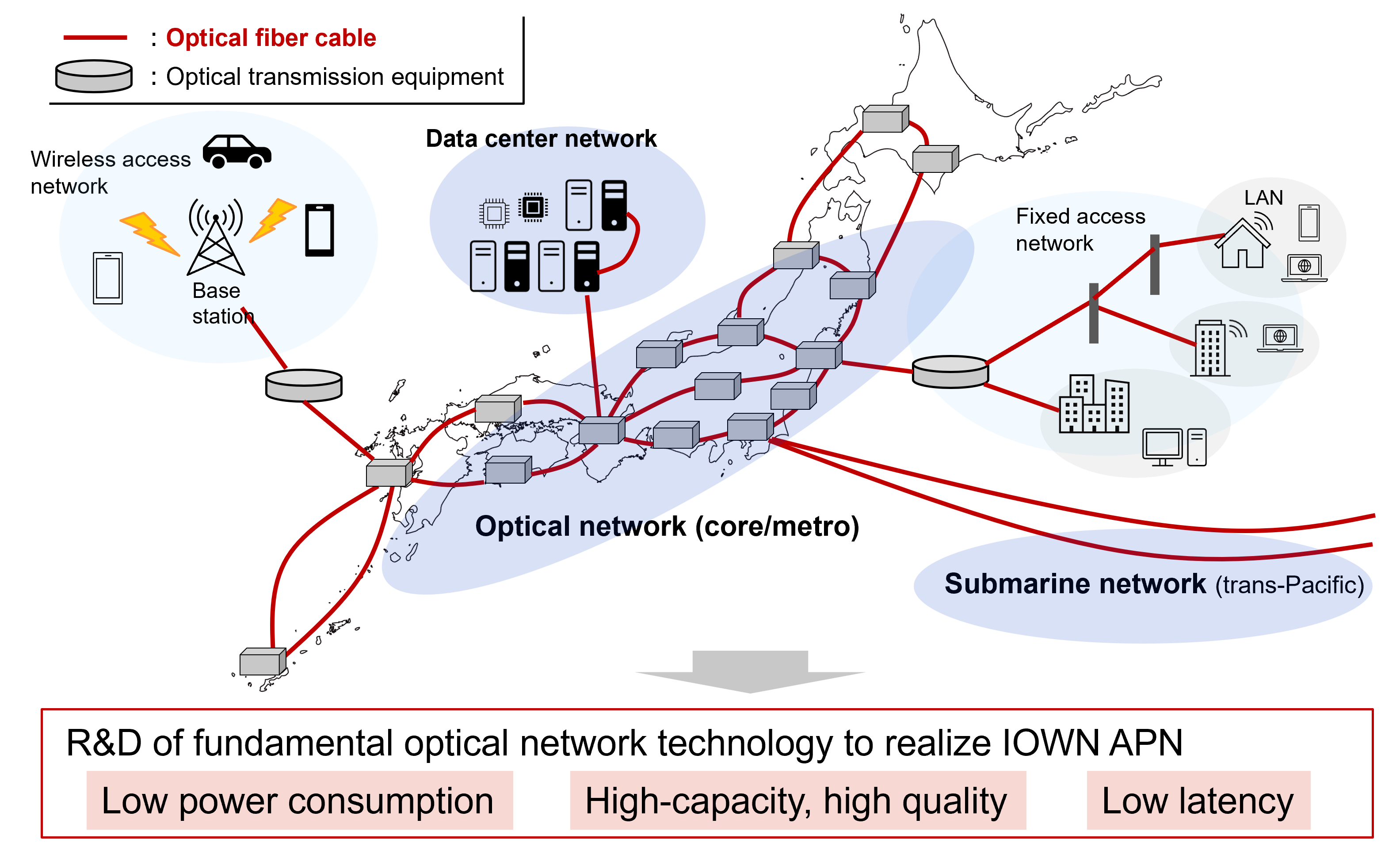
We introduce below four representative technologies being researched and developed by the Transport Innovation Laboratory.
- Ultra-high-capacity digital-coherent optical transmission
- Digital coherent optical transmission technology
- End-to-end optical signal power monitoring technology
- Extreme Layer 1 network
Ultra-high-capacity digital-coherent optical transmission
Digital coherent optical transmission technology
As shown in Fig. 1, the Transport Innovation Laboratory has been engaged in increasing the distance and capacity of optical communication systems through innovations in optical transmission technology. At present, we are working to support further increases in capacity by taking the technological lead internationally in the R&D of digital coherent optical transmission.
As shown in Fig. 2, digital coherent optical transmission achieves ultra-high-capacity transmission of information by exploiting the properties of a light wave. Information is encoded in a light wave's amplitude, phase and polarization. At the receiver, waveform data is acquired by digital sampling, and high-speed digital signal processing is applied to compensate for waveform distortions that occur in optical fibers and within the transmitter and receiver. Digital coherent optical transmission technology thus achieves tremendous ultra-high-speed transmission.
Besides research of basic technology for digital coherent optical transmission, we are also developing and practicalizing large-scale integration (LSI) of digital signal processor (DSP), a component essential for digital coherent optical transmission and critical for determining transmission quality. Fig. 3 shows the progress in NTT's research and development of coherent DSP. Our development is oriented along two types of applications: telecom, which requires high-capacity, high-performance, and long-distance communication; and datacom, which calls for low power consumption, high-density, and short-distance communication. The initial transmission capacity achieved was 100 Gbps per optical wavelength and the DSP was fabricated on 40-nm CMOS process node. Recently, we achieved a maximum transmission capacity of 1.2 Tbps and fabrication on 3-nm CMOS process node. Currently, we are engaged in R&D to achieve 1.6 Tbps.
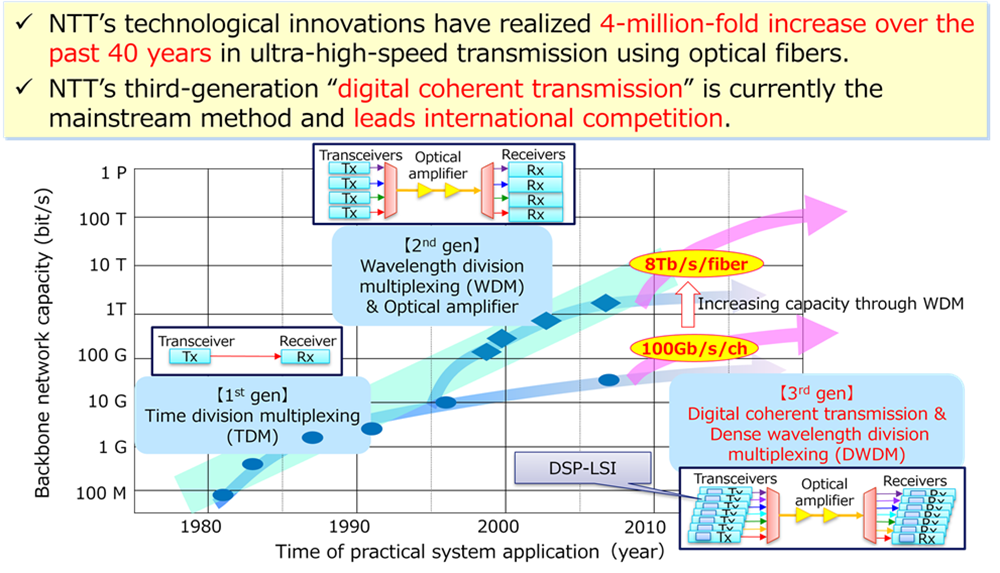
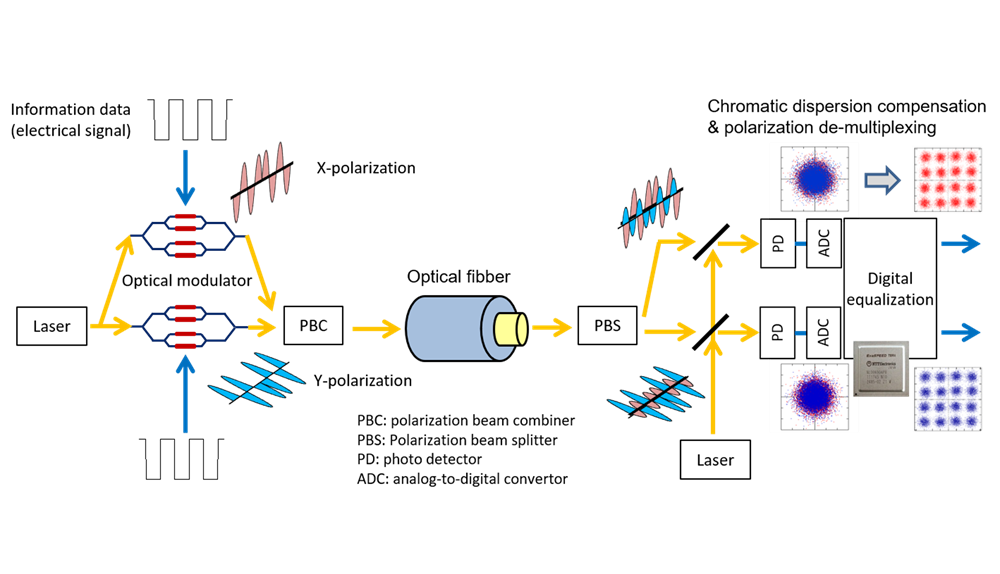
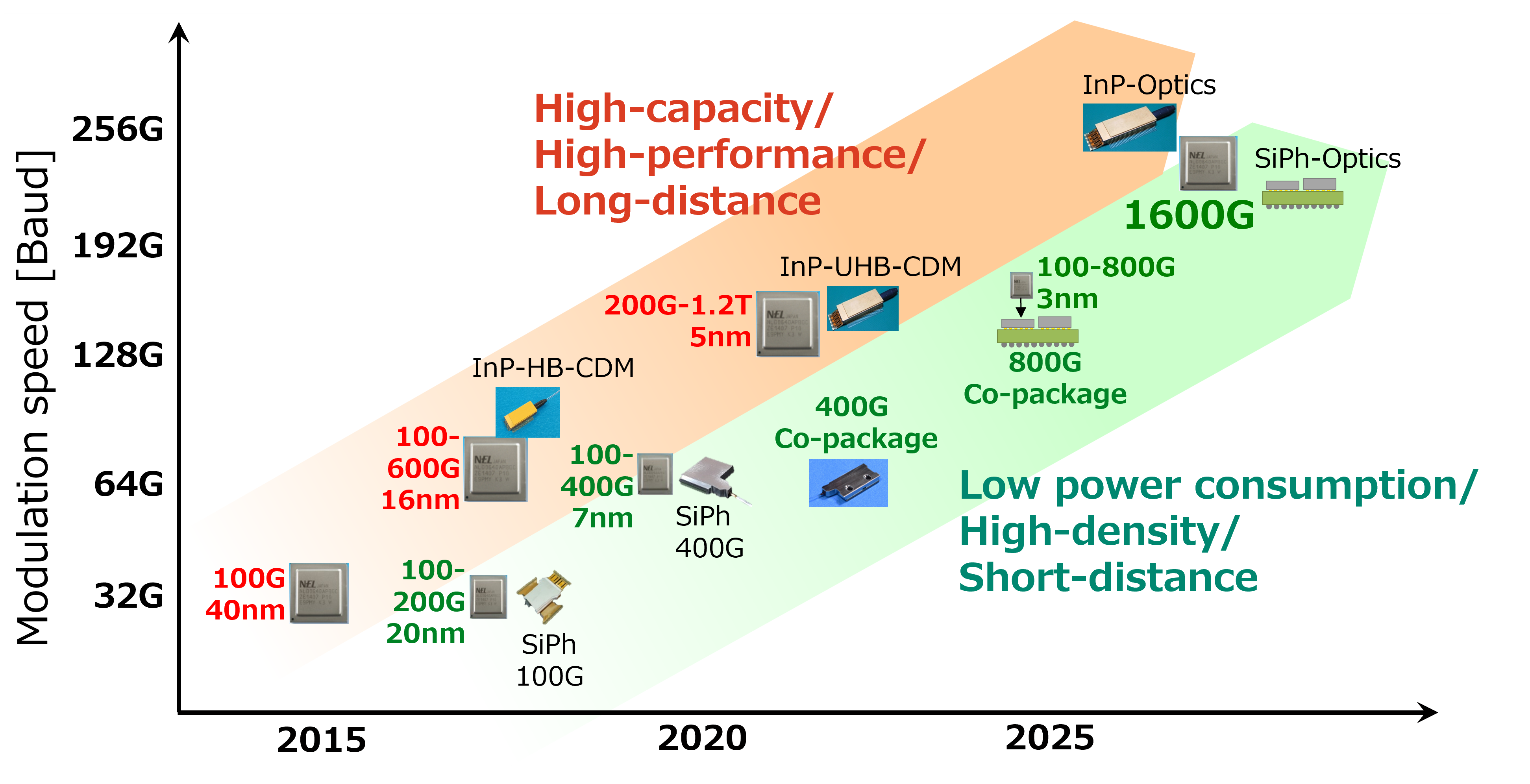
[Related Links]
■Press Releases
■References
[2]M. Nakamura et al., "Over 2-Tb/s net bitrate single-carrier transmission based on >130-GHz-bandwidth InP-DHBT baseband amplifier module," in Proc. Eur. Conf. Opt. Commun., 2022, pp. 1-4.
-
[3]F. Hamaoka, M. Nakamura, T. Kobayashi, Y. Miyamoto, E. Yamazaki, and Y. Kisaka, "S+C+L WDM coherent transmission with >1-Tb/s/λ signals," in Proc. OFC, 2024, paper Th3E.3.
-
[4]H. Kawakami, T. Kobayashi, and Y. Kisaka, "Multiple Beat-Noise Suppression in Polarization-Multiplexed Pump Light for Forward-Pumped Raman Amplifier," Journal of Lightwave Technology Vol. 41, Issue 12, pp. 3892-3897, 2023.
-
[5]S. Okamoto, K. Minoguchi, F. Hamaoka, et al., "A Study on the Effect of Ultra-Wide Band WDM on Optical Transmission Systems", Journal of Lightwave Technology, Vol. 38, Issue 5, pp. 1061-1070, 2020.
End-to-end optical signal power monitoring technology
To maximize an optical network's data transmission capacity, it is necessary to monitor the state of the transmission path, such as anomalies in the optical fibers, along its entire length and control the optical signal power appropriately. Conventionally, specialized instruments such as optical time domain reflectometers (OTDR) are used for this purpose. However, this method required the measurement at all optical nodes by a large number of sensors or instruments, incurring significant time and cost. The Transport Innovation Laboratory has developed Digital Longitudinal Monitoring (DLM), which visualizes an end-to-end optical signal power profile along a fiber-optic link solely by processing the signal reaching an optical receiver installed at network endpoints without the use of specialized measuring instruments (Fig. 4). This technology makes it possible to easily determine locations of loss anomalies in the optical fiber, enabling prompt network maintenance and selection of the optimal transmission mode for transmission path conditions.
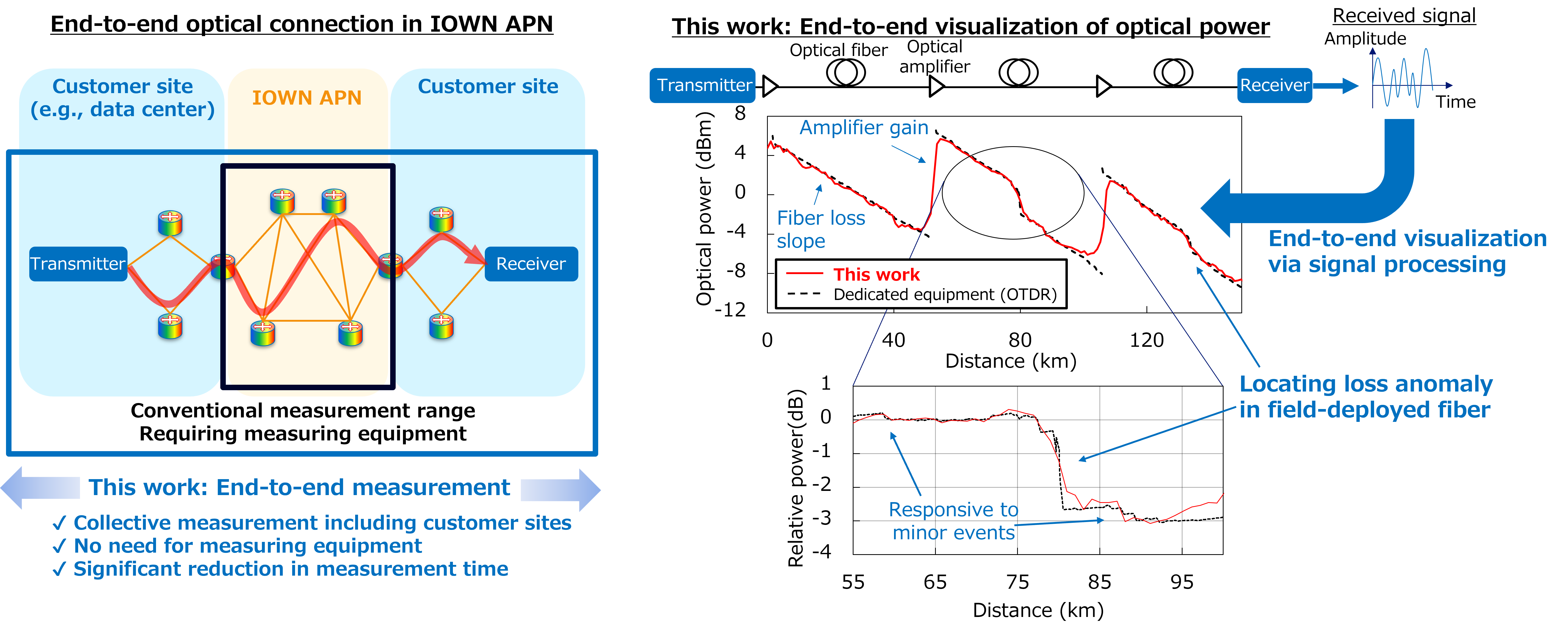
[Related Links]
■Press Releases
■References
[2]T. Sasai, M. Nakamura, E. Yamazaki, S. Yamamoto, H. Nishizawa and Y. Kisaka, "Digital Longitudinal Monitoring of Optical Fiber Communication Link," Journal of Lightwave Technology, vol. 40, no. 8, pp. 2390-2408, 15 April15, 2022, doi: 10.1109/JLT.2021.3139167.
-
[3]T. Sasai, E. Yamazaki and Y. Kisaka, "Performance Limit of Fiber-Longitudinal Power Profile Estimation Methods," Journal of Lightwave Technology, vol. 41, no. 11, pp. 3278-3289, 1 June1, 2023, doi: 10.1109/JLT.2023.3234534.
-
[4]M. Takahashi, T. Sasai, E. Yamazaki and Y. Kisaka, "Monitoring PDL Value and Location Using DSP-Based Longitudinal Power Profile Estimation," Journal of Lightwave Technology, vol. 42, no. 17, pp. 5866-5873, 1 Sept.1, 2024, doi: 10.1109/JLT.2024.3407722.
-
[5]R. Kaneko, T. Sasai, F. Hamaoka, M. Nakamura and E. Yamazaki, "Fiber Longitudinal Monitoring of Inter-band-SRS-induced Power Transition in S+C+L WDM Transmission," 2024 Optical Fiber Communications Conference and Exhibition (OFC), San Diego, CA, USA, 2024, pp. 1-3.
Extreme Layer 1 network
Delay managed network technology
In addition to reducing network latency, the Transport Innovation Laboratory is also carrying out investigation of Layer 1 delay management technology, which makes it possible for end users to control the latency of their signals. The technology enables flexible configuration and modification of the communication environment between remote locations in accordance with use cases. This makes possible stress-free implementation of remote activities such as remote ensemble performances and remote e-sport tournaments. This technology is included in terminal equipment of "APN IOWN 1.0" service provided by NIPPON TELEGRAPH AND TELEPHONE EAST CORPORATION and NIPPON TELEGRAPH AND TELEPHONE WEST CORPORATION, and " APN専用線プラン powered by IOWN (in Japanese)," provided by NTT Communications. In addition, we are also conducting research and development of technology that support signals close to users, such as USB and HDMI signals. This technology makes it possible to implement high-end, interactive communication between remote locations and eliminate the sense of unnaturalness in user experience due to communication latency by controlling it.
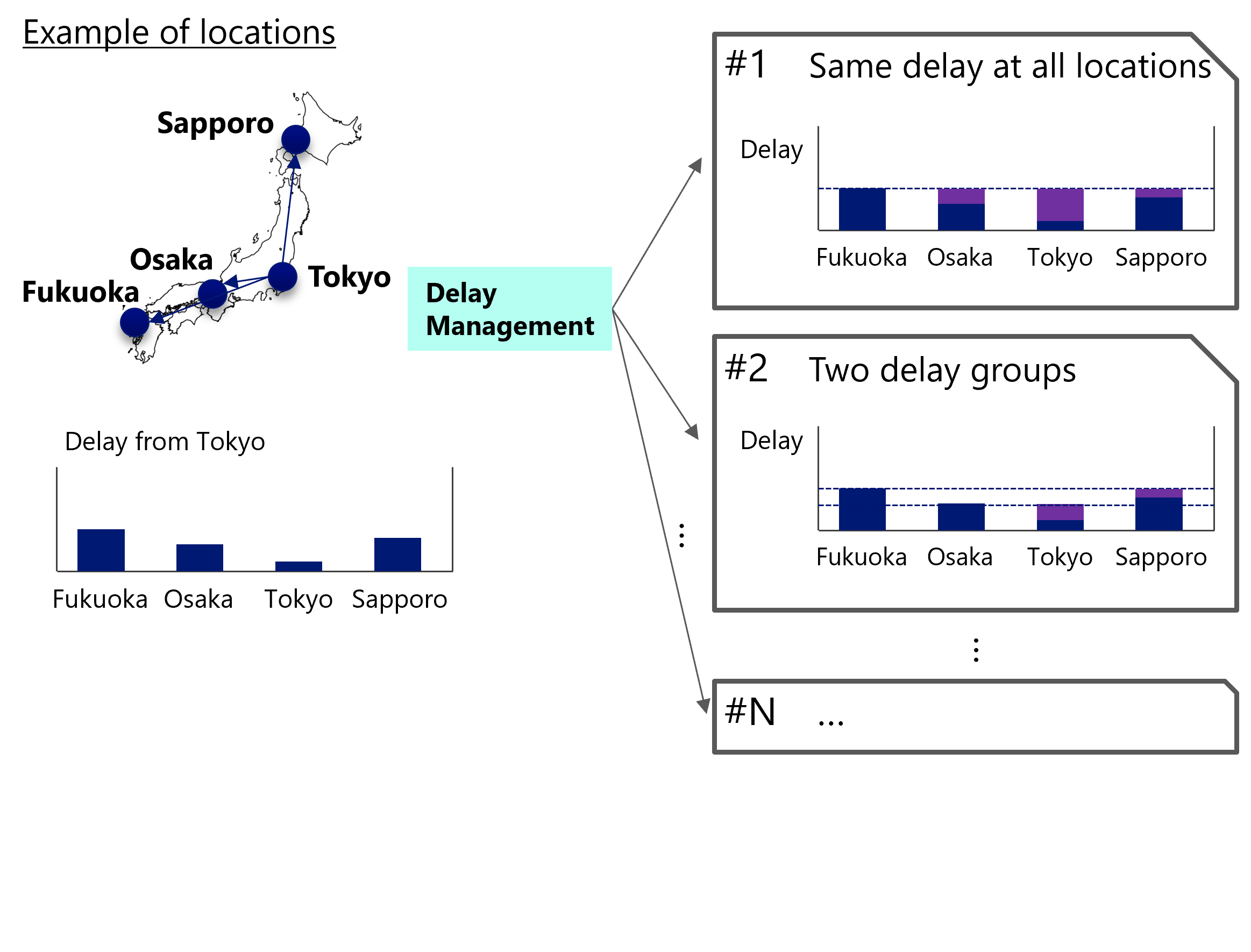
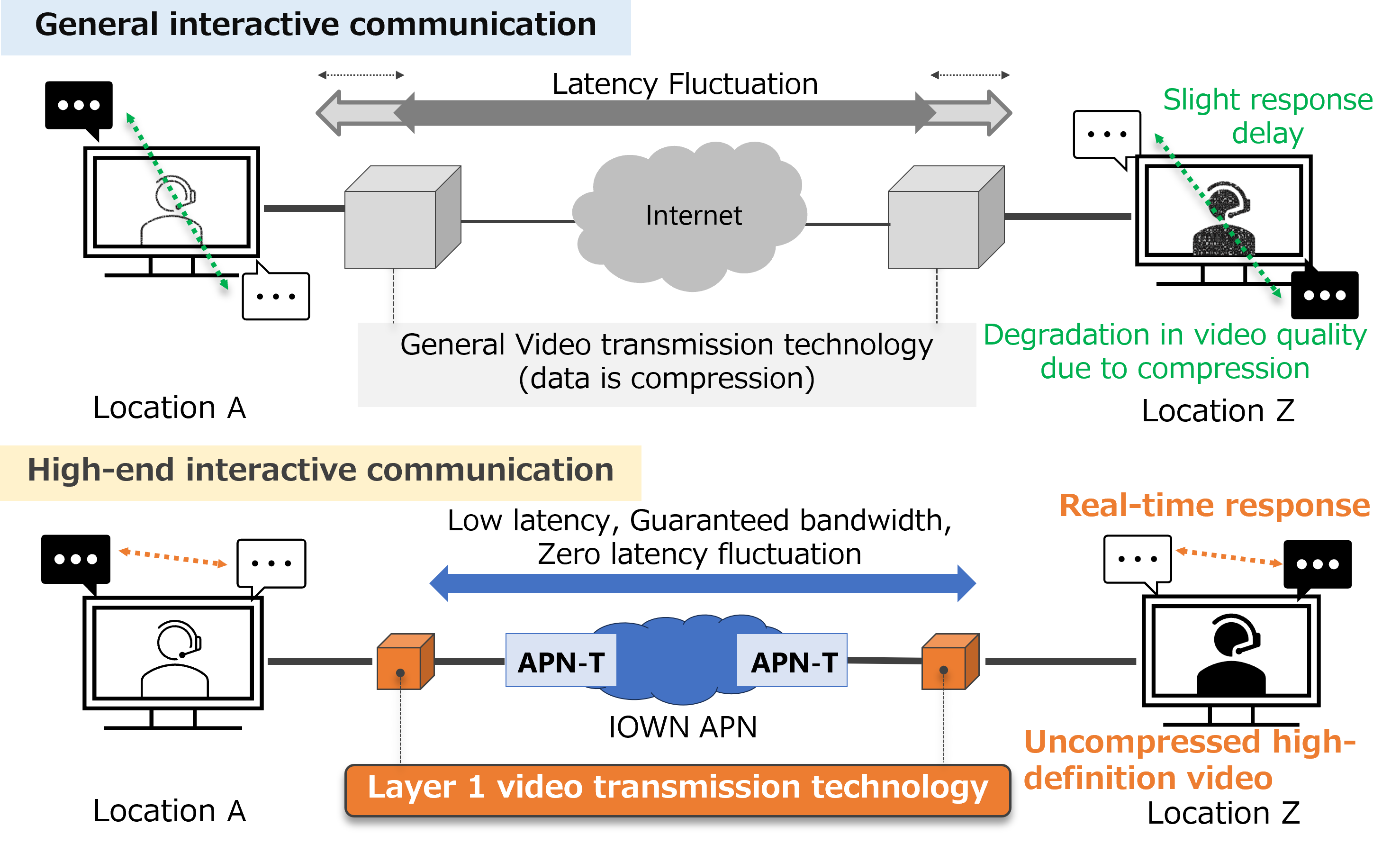
Overview of delay managed network technology
* This content was posted on Mar. 2025.
[Related Links]
■Press Releases
-
[1]Unprecedented Optical Network Technologies to Support Esports Achieving Breathtaking Gaming UX in Remote Esports Events
-
[2]NTT東日本リリース:APN IOWN1.0の提供開始について (in Japanese)
-
[3]NTT西日本リリース:APN IOWN1.0の提供開始について (in Japanese)
-
[4]NTTコミュニケーションズリリース:「APN専用線プランpowered by IOWN」の提供を開始
~拡大するAI活用や映像伝送などの大容量・低遅延のニーズに対応~ (in Japanese)
■NTT Technical Review
-
[5]Delay Managed Network for APN IOWN1.0
[1]T. Tanaka, "Reinforcement Learning-based Path Planning in Multilayer Elastic Optical Networks," Journal of Optical Communications and Networking, vol. 16, no. 1, pp. A68-A77, Jan. 2024.
[2]S. Sakurai, K. Higashimori, T. Ohara, "Applying Auxiliary Graph for Multi-band Network Planning Based on Hierarchical Optical Cross-Connects," 2025 OFC, Th1H, 2025
[3]K. Higashimori, T. Tanaka, T. Inoue, "Efficient Routing Method for Reducing Significant Outages in Optical Networks," IEEE GLOBECOM 2023, Best Paper Award (Optical Networks and Systems Symposium)
[4]K. Higashimori, T. Inoue, "Dynamic Topology Control of LEO Satellite Networks for Non-uniformly Distributed Traffic" IEEE GLOBECOM 2024 (SAC - Satellite and Space Communications Symposium)

07/26/2024
R&D Activities of C...
NTT and NTT DOCOMO are working together to implemen...
from NTT Technical Review
02/02/2024
Standardization Trends ...
Confronted by the development of various services, ...
from NTT Technical Review
10/02/2023
Delay Managed Network f...
This article introduces the concept of the Delay Ma...
from NTT Technical Review
06/30/2023
Turning an Innovative I...
With the increase in video-data distribution, the d...
from NTT Technical Review
04/28/2023
Petabit-class Optical T...
Over the last 40 years, various innovations in tech...
from NTT Technical Review
09/08/2022
C+L-band Colorless, Dir...
We investigated the possibility of expanding the op...
from NTT Technical Review
08/05/2022
Future Development of D...
Digital coherent optical transmission technology-wh...
from NTT Technical Review
08/05/2022
Research and Developmen...
Research and development at NTT Network Innovation ...
from NTT Technical Review
09/30/2020
Sharing Moments of &quo...
Yutaka Miyamoto / Fellow, NTT Network Innovation La...
from NTT Technical Review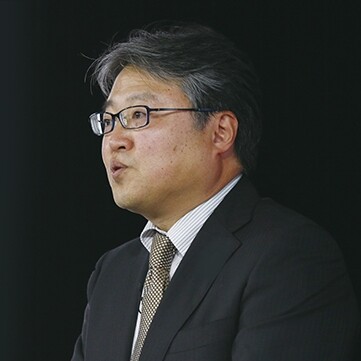
03/01/2020
Basic Technologies towa...
Tetsuomi Sogawa / Senior Vice President, Head of NT...
from NTT Technical Review
03/01/2020
Innovative Network for ...
Arata Itoh / Senior Vice President, Head of NTT Inf...
from NTT Technical Review
Advanced network design technology utilizing mathematical models and machine learning
The capabilities demanded of infrastructure continue to evolve. Needs include dealing with ever-increasing Internet traffic and ensuring that connectivity is maintained during disasters. Communications service providers face the need to fulfill these conditions while efficiently utilizing limited communication infrastructure resources.
To meet these demands, we are researching highly reliable and highly efficient network design technology based on advanced mathematical models and machine learning techniques. We are engaged in applying our developed technology to not only issues related to terrestrial backbone optical networks but also to other areas such as satellite networks.

[Related Links]
■References